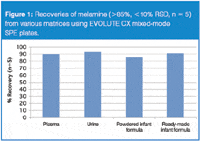High Throughput Extraction of Melamine using EVOLUTE CX Mixed-mode SPE Plates
The Application Notebook
The use of EVOLUTE CX mixed-mode columns provides high and consistent recoveries across a range of complex matrices, from biological fluids to milk products. The dual retention mechanism ensures that matrix components such as proteins, salts and phospholipids are removed, resulting in lower ion suppression and accurate analysis.
Lee Williams and Joanna Caulfield, Biotage GB Ltd, Uppsala, Sweden.
Introduction
The use of mixed-mode solid-phase extraction (SPE) provides significant selectivity advantages compared with non-polar resin-based SPE. Resin-based mixed-mode cation exchange SPE sorbents provide a dual retention mechanism, allowing for the use of a rigorous interference elution regime. This significantly improves extract cleanliness and reduces matrix effects in LC–MS–MS analysis.
This application note from Biotage describes the high-throughput extraction of melamine from biological fluids and various infant formula products using EVOLUTE CX mixed-mode resin-based SPE.
Sample Preparation Procedure
EVOLUTE CX configuration
EVOLUTE CX 25 mg fixed-well plate (part number 601-0025-P01)
EVOLUTE CX procedure
Sample: Sample spiked at 100 ng/mL
Sample pre-treatment: Dilute samples [1:3 (v/v), 100 μL] with 0.05 M NH4OAc, pH 5 (total analyte load 10 ng). Make up powdered milk according to manufacturer's instructions.
Column conditioning: Methanol (1 mL)
Column equilibration: 0.05 M NH4OAc, pH 5 (1 mL)
Sample application: Apply diluted sample (400 μL)
Interference elution 1: Rinse with 0.05 M NH4OAc, pH 5 (1 mL)
Interference elution 2: Rinse with methanol (1 mL)
Analyte elution: Methanol/NH4OH (95:5 (v/v), 500 μL)
Post extraction: Evaporate to dryness and reconstitute in ACN/water (90:10, 500 μL) for subsequent LC–MS–MS analysis
For general guidelines on the use of EVOLUTE CX SPE plates and columns, request chemistry data sheet
TN139 EVOLUTE CX columns for solid-phase extraction in bioanalysis.
HPLC conditions
Instrument: Waters 2795 liquid handling system (Waters Assoc., Milford, Massachusetts, USA)
Column: LUNA HILIC LC column (100 × 2.0 mm, 3 μ)
Mobile phase: Isocratic 75:25 ACN/0.02 M ammonium formate v/v at pH 3.2 at a flow-rate of 0.3 mL/min
Injection volume: 25 μL
Temperature: Ambient
Mass spectrometry
Instrument: Ultima Pt triple quadrupole mass spectrometer (Waters Assoc., Manchester, UK) equipped with an electrospray interface for mass analysis. Positive ions were acquired in the multiple reaction monitoring mode (MRM) 127.0 > 85.0 and 127.0 > 68.0.
Desolvation temperature: 350 °C
Ion source temperature: 100 °C
Collision gas pressure: 2.4 × 10–3 mbar
Results

Figure 1

Table 1: Summary of recoveries and RSDs for the extraction of melamine from various sample matrices.
Conclusions
The use of EVOLUTE CX mixed-mode SPE plates provides high recoveries and low RSDs for high throughput analysis of melamine in biological fluids and milk-based infant formula products.
For higher sample volumes or more viscous samples EVOLUTE CX 50 μm is available in larger SPE column formats.
EVOLUTE is a registered trademark of Biotage.

Biotage GB Ltd
Kungsgatan 76, SE-753 18 Uppsala, Sweden
tel. +46 18 56 57 10 fax +46 18 56 57 05
Website: www.biotage.com












